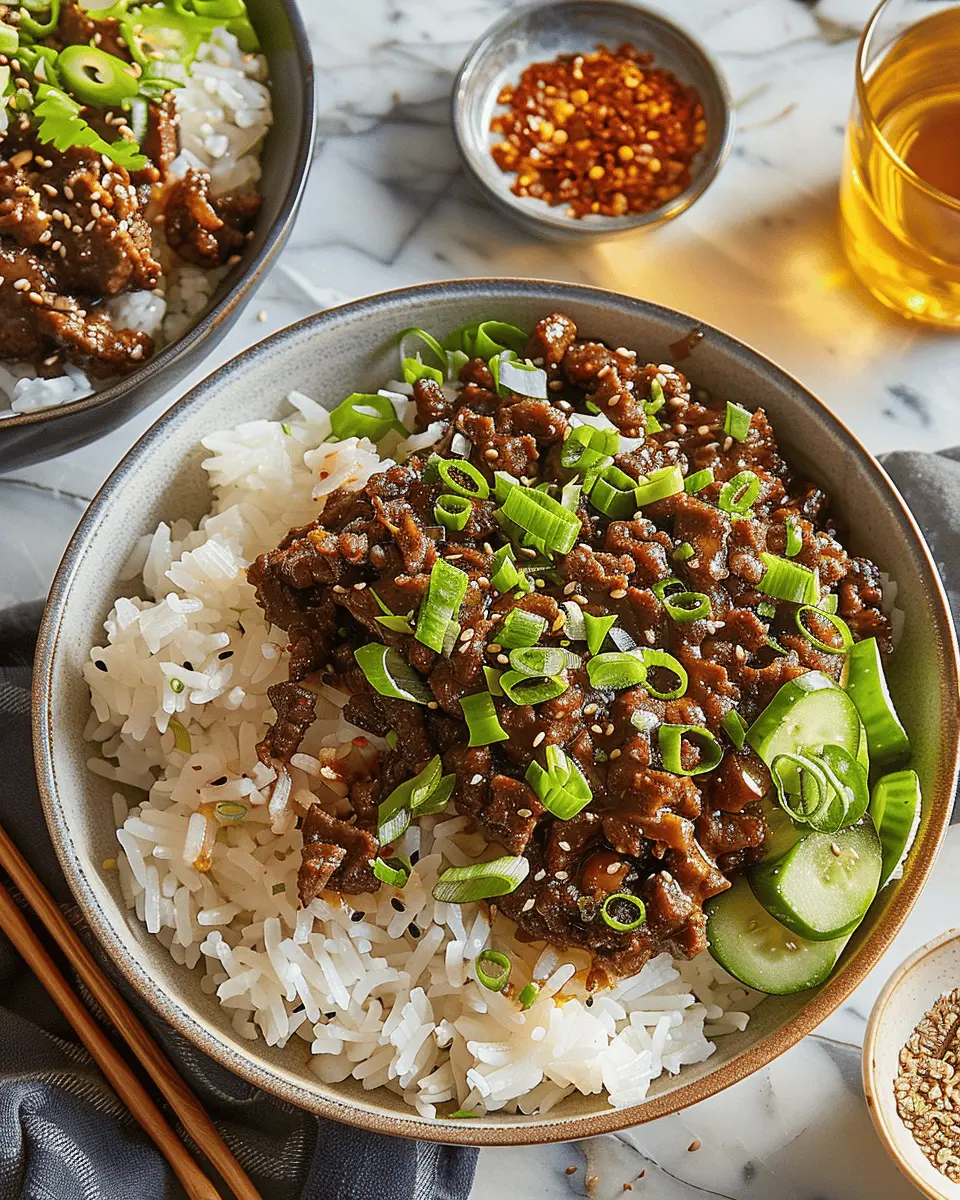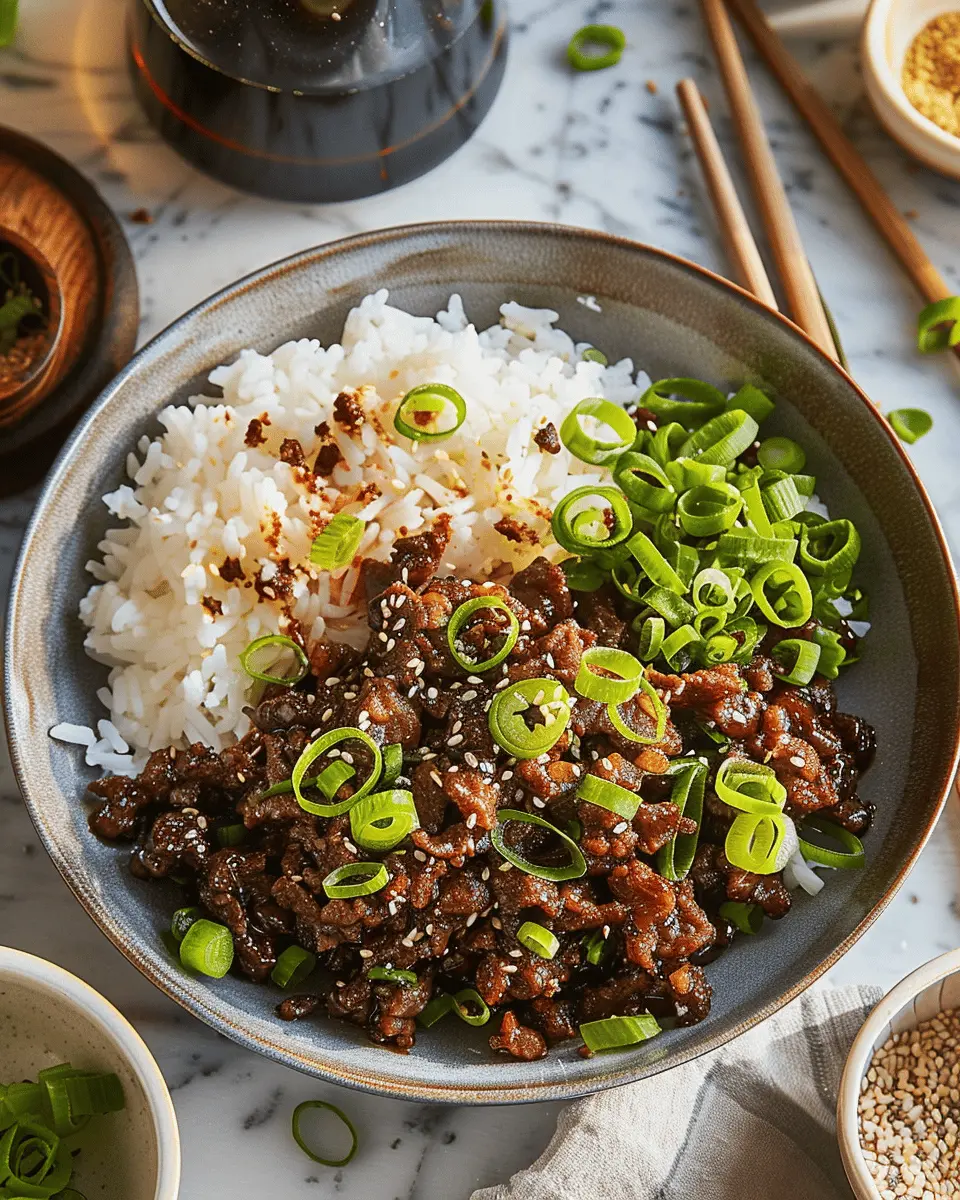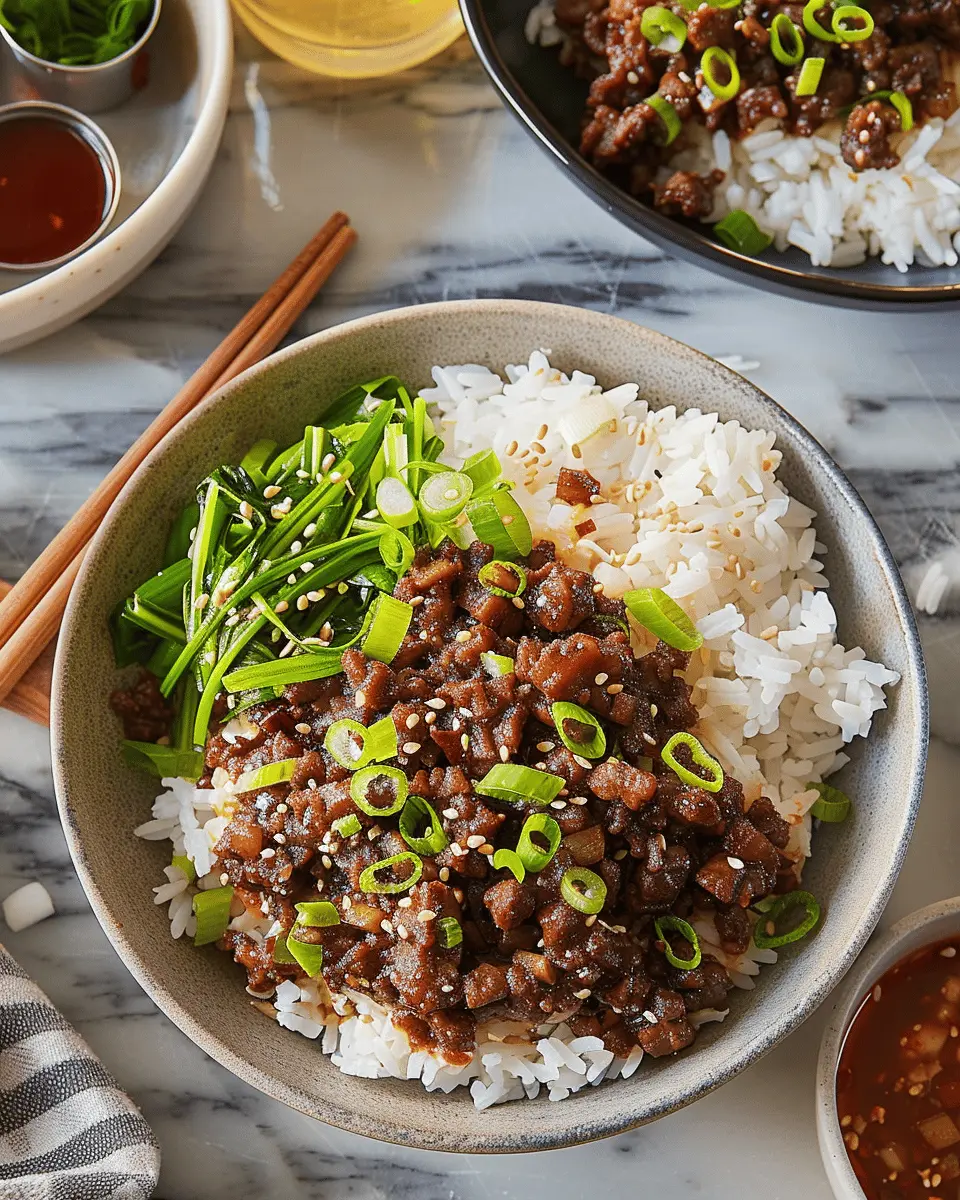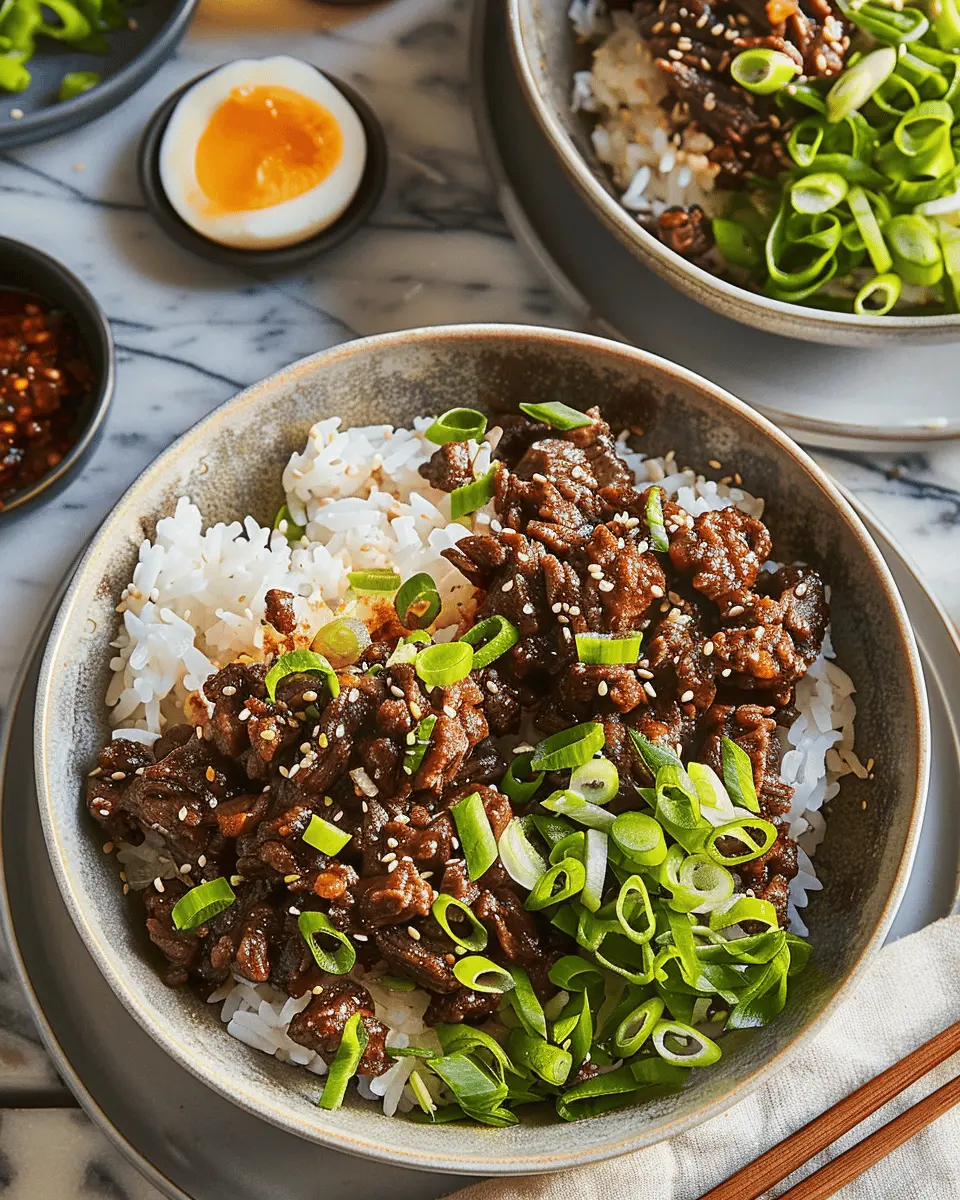Introduction to Korean Beef Bowl
If you’re looking to spice up your dinner routine, a Korean Beef Bowl is just the ticket! This dish has gained immense popularity for a reason: it’s not only delicious but also quick and easy to prepare. Imagine a colorful bowl filled with tender slices of marinated beef, fresh vegetables, and perfectly cooked rice, all drizzled with a savory sauce. It’s a perfect blend of flavors that brings a taste of Korea into your home.
What is a Korean Beef Bowl and why is it popular?
So, what exactly is a Korean Beef Bowl? At its core, this dish features marinated beef, typically stir-fried to perfection, served over a bed of rice with an assortment of toppings. Common ingredients include:
- Marinated Beef: Usually bulgogi, which is thinly sliced beef marinated in a mixture of soy sauce, sesame oil, garlic, and sugar for that perfect balance of salty and sweet.
- Fresh Vegetables: Think crunchy bok choy, vibrant carrots, and scallions that add texture and color.
- Egg: Often poached or fried, providing a rich, creamy element on top.
The beauty of a Korean Beef Bowl lies in its simplicity and versatility. You can customize it to cater to your taste preferences or dietary needs by swapping in turkey bacon for a health-conscious alternative or adding more veggies for a wholesome twist.
The popularity of this dish can also be traced to the rise of Korean cuisine globally. According to the Food & Agriculture Organization, there’s been a significant increase in interest in Korean food over the last decade. People are drawn to the rich flavors, the balance of spices, and the option for nutritious, quick meals that fit into busy lifestyles.
Plus, whipping up a Korean Beef Bowl at home can be a delightful culinary adventure! It’s an excellent opportunity to practice your cooking skills and impress friends or family with a surprisingly impressive dish. Whether you’re enjoying it for a regular weeknight dinner or a casual gathering, the Korean Beef Bowl often leaves everyone craving seconds.
For more insights about the cultural significance and the variations of Korean dishes, check out resources like Korean Food Foundation and BBC Good Food. They offer great articles that deepen your understanding of this flavorful cuisine.

Ingredients for Korean Beef Bowl
Essential ingredients
Creating a delicious Korean Beef Bowl starts with the right ingredients. Here’s what you’ll need:
- Ground beef: This is your protein base. Opt for lean beef for a healthier option.
- Soy sauce: Adds that umami flavor that makes Korean dishes so enticing.
- Garlic: Fresh garlic gives a punch, enhancing the overall taste.
- Ginger: A little fresh ginger goes a long way in adding depth.
- Brown sugar: Balances the saltiness of soy sauce and brings sweetness to the dish.
- Sesame oil: Just a drizzle will amp up that authentic flavor.
- Green onions: Perfect for garnish and add a fresh crunch.
Optional add-ins
Want to customize your Korean Beef Bowl? Here are some super handy optional ingredients:
- Turkey bacon or Chicken ham: For a smoky, savory twist.
- Vegetables: Think sliced bell peppers or steamed broccoli for a colorful crunch.
- Rice or quinoa: These are great bases to soak up the bold flavors.
- Kimchi: For those who like a spicy kick!
For more tips on customizing your bowls, check out this article on assembling the perfect bowl. Happy cooking!
Preparing a Korean Beef Bowl
Creating a Korean Beef Bowl at home is a delightful way to explore the delicious flavors of Korea without ever having to leave your kitchen. The combination of tender marinated beef, perfectly cooked rice, and vibrant veggies makes this dish not just satisfying but also bursting with flavor. Let’s dive into how to prepare this tasty meal step by step!
Gather Your Ingredients
Before you start cooking, it’s crucial to gather all the ingredients. Here’s what you’ll need:
- Beef: Thinly sliced flank steak or sirloin works great. You could also use pre-sliced beef for convenience.
- Marinade:
- Soy sauce
- Brown sugar
- Sesame oil
- Garlic (minced)
- A dash of black pepper
- Rice: Short-grain rice is ideal, but you can use jasmine or brown rice if preferred.
- Vegetables:
- Sliced green onions
- Shredded carrots
- Bell peppers (sliced)
- Garnishes:
- Sesame seeds
- Additional green onions
- Soft-boiled eggs (optional, but highly recommended)
Gathering your ingredients first will save you time and keep you organized throughout the cooking process, which is key to enjoying the experience.
Marinate the Beef
Once you’ve got your ingredients ready, it’s time to marinate the beef. This is where the flavor magic begins! In a bowl, combine:
- ¼ cup soy sauce
- 2 tablespoons brown sugar
- 1 tablespoon sesame oil
- 2 cloves minced garlic
- A pinch of black pepper
Add your sliced beef to this marinade, ensuring each piece is well-coated. Let it marinate for at least 30 minutes, or if you have the time, let it sit for up to two hours or even overnight in the fridge. This not only enhances the flavor but also tenderizes the meat. For best practices on marinading, check out this culinary guide.
Cook the Beef
Now comes the exciting part—cooking the beef. Heat a skillet or wok over medium-high heat and add a splash of oil. Once it’s hot, toss in the marinated beef, making sure to shake off excess marinade. Sauté for 2-3 minutes until the beef is browned and cooked through. Don’t overcrowd the pan; if you have a lot of beef, cook it in batches so it sears nicely rather than steams.
As the beef cooks, you may want to add your vegetables. Toss in the sliced bell peppers and shredded carrots for the last minute of cooking for a touch of crunch.
Prepare the Rice
While your beef is sizzling away, it’s time to prepare the rice. Rinse 1 cup of rice under cold water until the water runs clear, which removes excess starch and helps achieve a fluffier texture. Cook according to your preferred method, whether that’s on the stovetop or in a rice cooker. For seasoned rice lovers, consider adding a pinch of salt and a drizzle of sesame oil during cooking for added depth.
Assemble the Bowl
Once everything is ready, it’s assembly time! Start with a generous base of rice in your bowl. Top it off with your beautifully cooked beef and the sautéed vegetables. For that finishing touch, sprinkle with sesame seeds and garnish with green onions. If you’re feeling fancy, add a soft-boiled egg on top. The richness of the egg pairs wonderfully with the Korean Beef Bowl.
And there you have it—a delicious, homemade Korean Beef Bowl that’s not only visually appealing but also full of flavor! Enjoy your meal, and feel free to share your creations on social media or with friends and family. Cooking can be a wonderful way to connect, and there’s nothing quite like sharing a bowl of goodness.

Variations on Korean Beef Bowl
Crafting a Vegetarian Version
For those looking to enjoy the flavors of a Korean Beef Bowl while sticking to a vegetarian diet, you’re in luck! Swapping beef with sautéed mushrooms or marinated tofu provides a hearty texture and absorbs the delicious marinade beautifully. You can even use jackfruit for a meat-like consistency! Consider adding:
- Soy sauce or tamari: For that rich umami flavor.
- Sesame oil: To add depth.
- Fresh veggies: Such as bell peppers and carrots for crunch.
This twist is not only filling but also packed with nutrients. Plus, it’s an excellent way to introduce more plant-based meals into your week. If you want to deepen your veggie experience, check out this resource on plant substitutes for further ideas.
Elevating with a Spicy Korean Beef Bowl
If you crave some heat in your Korean Beef Bowl, it’s easy to kick things up a notch! You can achieve this by adding gochujang (a spicy Korean chili paste) or a sprinkle of red pepper flakes to your beef marinade. Here are some ways to make it even more exciting:
- An extra kick: Incorporate sliced jalapeños for added heat.
- Spicy pickled veggies: Use kimchi to bring both spice and tanginess.
- Chili oil drizzle: A finishing touch that’ll make every bite pop.
These adjustments will take your dish from good to unforgettable, making it a true flavor adventure. For more ideas on chili pastes, check out this culinary guide, which dives deep into spice options!
Cooking tips and notes for Korean Beef Bowl
Tips for perfect marination
Marinating your beef is key to infusing flavor into your Korean Beef Bowl. Aim for at least 30 minutes, but if you can let it sit overnight, do it! Use a mix of soy sauce, brown sugar, sesame oil, and fresh ginger to create a well-rounded flavor profile. Always remember to balance the saltiness with a bit of sweetness. Too much soy sauce can overwhelm the dish. If you’re looking for guidance, check out resources like Serious Eats for marinating techniques.
How to cook beef correctly
When it comes to beef, slicing against the grain is a game changer. This technique ensures tender bites every time. For cooking, a hot skillet or wok will give your meat a beautiful sear—don’t overcrowd the pan! This allows for that lovely caramelization without steaming your beef. If you’re using Turkey Bacon or Chicken Ham for a twist, remember to adjust the cook time slightly, as these can cook faster than traditional cuts.
With these tips, you’re all set to create an unforgettable Korean Beef Bowl. Enjoy the process and make it your own!

Serving Suggestions for Korean Beef Bowl
Ideal Side Dishes
To complement your Korean Beef Bowl, consider pairing it with classic sides that enhance the dish’s vibrant flavors. Here are some great options:
- Steamed Rice: Use white or brown rice for a wholesome base, or try cauliflower rice for a low-carb alternative.
- Kimchi: This spicy, fermented cabbage dish adds a tangy flair and is a staple in Korean cuisine. Check out this easy kimchi recipe for a homemade touch.
- Vegetable Stir-Fry: Sauté a mix of veggies like bell peppers and broccoli with soy sauce for a burst of color and nutrients.
Garnishes to Enhance Flavor
Make your Korean Beef Bowl visually appealing and even more delicious with thoughtful garnishes:
- Chopped Green Onions: A sprinkle of fresh green onions adds a lovely crunch and mild onion flavor.
- Sesame Seeds: Toasted white or black sesame seeds can bring a delightful nuttiness to your dish.
- Sriracha or Gochujang: For those who like it spicy, a drizzle of Sriracha or Gochujang enhances the heat and variety.
These simple yet impactful additions will elevate your meal and impress your guests with their bold flavors and beautiful presentation. Enjoy your culinary adventure!
Time breakdown for Korean Beef Bowl
When you’re in the mood for a delicious yet quick meal, this Asian-inspired Korean Beef Bowl fits perfectly into your busy schedule. Here’s a handy breakdown of the time you’ll need to whip it up smoothly.
Preparation time
Getting everything ready is a breeze! Spend about 15 minutes chopping your veggies and marinating the beef. Feel free to put on your favorite playlist while you chop—the time will fly by!
Cooking time
Once you’re prepped, cooking takes around 10-15 minutes. You’ll be amazed at how quickly everything comes together.
Total time
With prep and cooking combined, you’re looking at a total of 30 minutes to enjoy your Korean Beef Bowl. Perfect, right? For more delicious ideas, check out this quick recipe guide to keep your weeknight dinners fresh and exciting!
Nutritional Facts for Korean Beef Bowl
When whipping up a delicious Korean Beef Bowl, it’s essential to be aware of its nutritional profile. Understanding what you’re putting in your body can help you enjoy your meal even more. Here’s a quick look at the key nutritional components:
Calories
A typical serving of Korean Beef Bowl contains approximately 480 calories. This makes it a filling option without being excessively heavy, perfect for those busy weeknights!
Protein
You’ll love the protein punch in this dish, as it packs around 30 grams of protein per bowl. This makes it an excellent choice for anyone looking to maintain energy during a hectic workday.
Sodium
However, be mindful of the sodium content—it can be about 800 mg per serving. While it’s great to flavor your dish, you might want to adjust the soy sauce used to keep sodium levels in check. For a healthier alternative, consider low-sodium soy sauce.
For more precise nutritional data, check reputable sources such as the USDA FoodData Central or NutritionData for insights tailored to your specific ingredients. Keeping a balance in your meals helps when you’re trying to live a healthy lifestyle, especially with flavorful dishes like the Korean Beef Bowl.
FAQs about Korean Beef Bowl
If you’re diving into the world of Korean Beef Bowls, you might have a few questions. Let’s unpack some common queries to help you whip up this delicious dish with confidence.
Can I use a different protein?
Absolutely! While beef is a traditional choice for Korean Beef Bowls, you can easily swap it out for other proteins. Options like chicken, turkey, or even tofu for a plant-based meal can work wonderfully. Keep in mind that cooking times may vary, so adjust accordingly to ensure everything is thoroughly cooked.
How can I make it less spicy?
If you’re sensitive to heat, there are several ways to tone down the spice level in your Korean Beef Bowl. Start by reducing the amount of gochujang (Korean chili paste) or try using a mild version. You can also incorporate more sugar or honey to balance the heat. Additionally, adding extra vegetables like carrots or bell peppers can dilute the spice without sacrificing flavor.
What alternative sauces can I use?
Not in the mood for the classic Korean flavors? Consider these alternatives:
- Teriyaki Sauce: For a sweeter glaze that still delivers on flavor.
- Soy Sauce: A great base, particularly when you’re looking for something less complex.
- Peanut Sauce: Perfect for a nutty twist, ideal if you’re pairing with fresh veggies.
Experimenting with these options not only diversifies your Korean Beef Bowl but also keeps your meals exciting. For more sauce ideas, check out Cooking Light for inspiration.
Hopefully, these answers spark your creativity and help you enjoy your culinary adventure with Korean Beef Bowls!
Conclusion on Korean Beef Bowl
Summary of Benefits and Encouragement to Try the Recipe
The Korean Beef Bowl is a delightful fusion of flavors that brings a satisfying balance of taste and nutrition to your table. Packed with protein from beef and enhanced with fresh vegetables, this dish is both nourishing and delicious. Plus, it’s quick to prepare, making it perfect for busy weeknights when you need a wholesome meal in a hurry.
Why not give this recipe a try? You’ll not only impress your friends and family with your culinary skills, but you’ll also enjoy a memorable meal that transports your taste buds straight to Korea. For more ideas on making wholesome dinners, check out resources like the Academy of Nutrition and Dietetics or Healthline. Enjoy cooking, and bon appétit!
PrintKorean Beef Bowl: Easy, Flavorful Comfort Food at Home
A delicious and easy recipe for a comforting Korean Beef Bowl that you can make at home.
- Prep Time: 10 minutes
- Cook Time: 15 minutes
- Total Time: 25 minutes
- Yield: 4 servings 1x
- Category: Main Dish
- Method: Stovetop
- Cuisine: Korean
- Diet: Non-vegetarian
Ingredients
- 1 pound ground beef
- 1/4 cup soy sauce
- 2 tablespoons brown sugar
- 2 cloves garlic, minced
- 1 teaspoon ginger, grated
- 2 green onions, sliced
- 1 teaspoon sesame oil
- 3 cups cooked rice
- 1/2 cup shredded carrots
- 1/2 cup cucumber, diced
Instructions
- In a skillet, brown the ground beef over medium heat.
- Drain excess fat and add soy sauce, brown sugar, garlic, and ginger.
- Cook for an additional 5 minutes until the sauce thickens.
- Stir in green onions and sesame oil.
- Serve over cooked rice, topped with shredded carrots and diced cucumber.
Notes
- For extra spice, add red pepper flakes.
- Feel free to add other vegetables like bell peppers.
Nutrition
- Serving Size: 1 bowl
- Calories: 450
- Sugar: 6g
- Sodium: 800mg
- Fat: 20g
- Saturated Fat: 7g
- Unsaturated Fat: 10g
- Trans Fat: 0g
- Carbohydrates: 40g
- Fiber: 3g
- Protein: 25g
- Cholesterol: 80mg
Keywords: Korean Beef Bowl, comfort food, easy recipe












